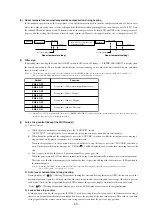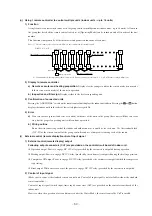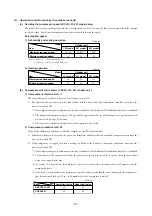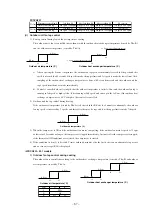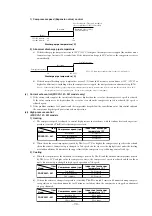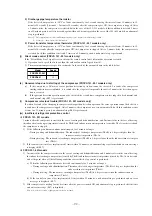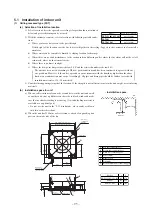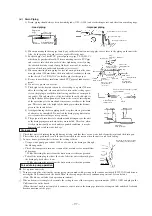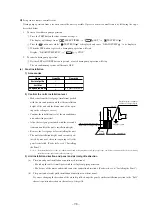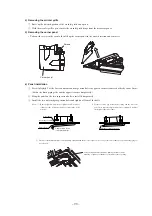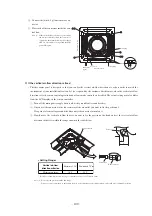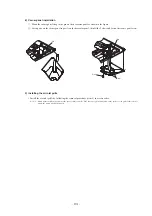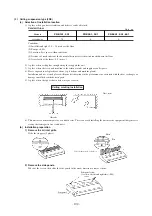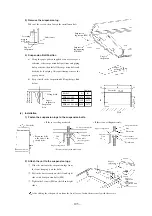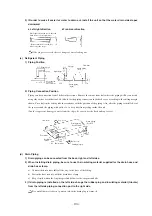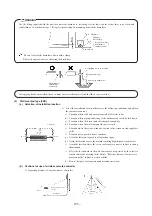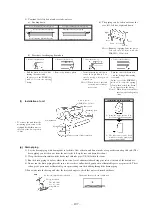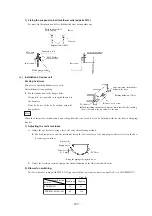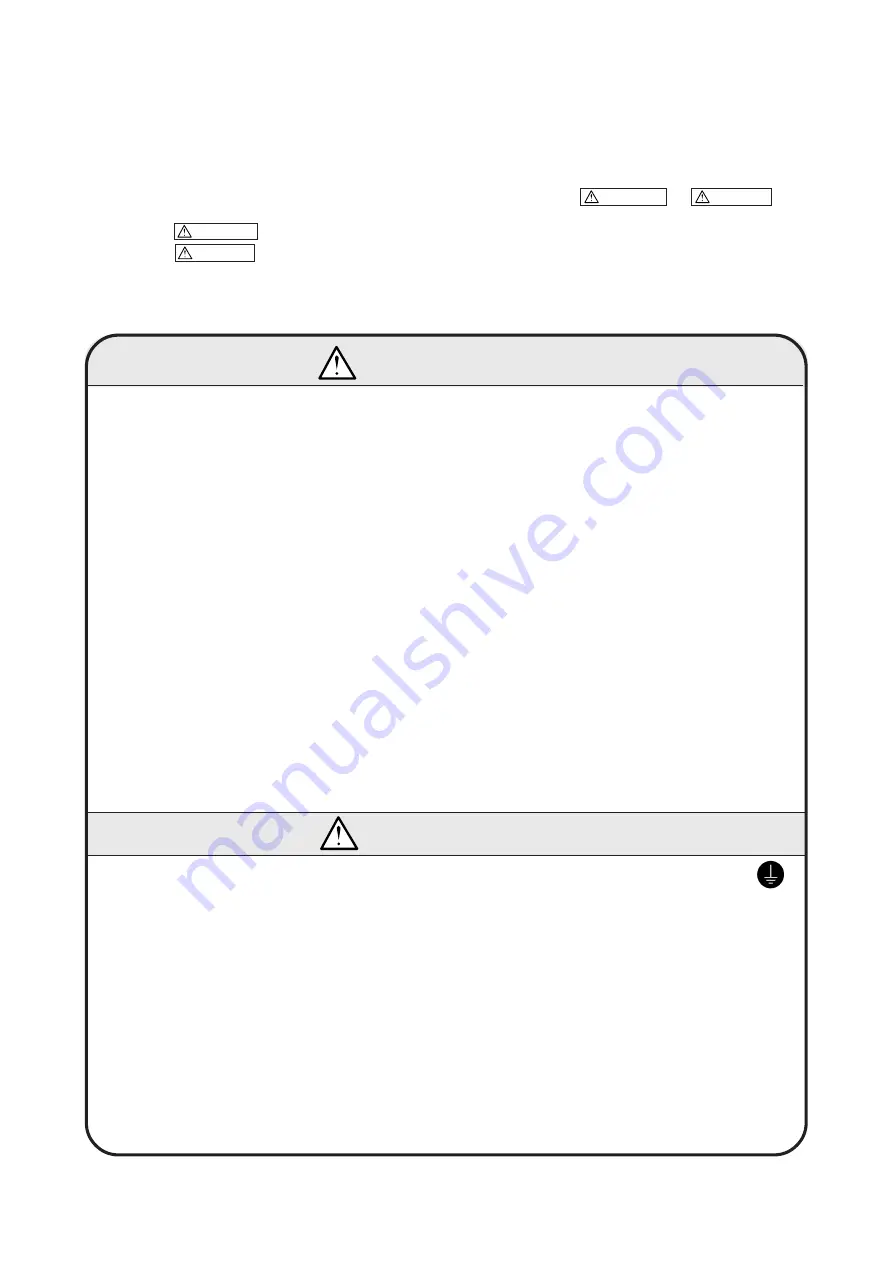
-
94
-
5
APPLICATION DATA
SAFETY PRECAUTIONS
•
Please read these “Safety Precautios” first then accurately execute the installation work.
•
Though the precautionary points indicated herein are divided under two headings,
WARNING
and
CAUTION
, those
points which are related to the strong possibility of an installation done in error resulting in death or serious injury are listed
in the
WARNING
section. However, there is also a possibility of serious consequences in relationship to the points listed
in the
CAUTION
section as well.
In either case, important safety related information is indicated, so by all means, properly observe all that is mentioned.
•
After completing the installation, along with confirming that no abnormalities were seen from the operation tests, please explain
operating methods as well as maintenance methods to the user (customer) of this equipment, based on the owner’s manual.
Moreover, ask the customer to keep this sheet together with the owner’s manual.
WARNING
¡
Installation should be performed by the dealer or a company speciallizing in this type of installarion. If you install the equipment
yourself, installation errors could result in water leaks, electric shock, and/or a fire, as well as other hazards.
¡
Conduct installation work in accordance with the instructions in this installation manual. Installation errors could result in water leaks,
electric shock, or fire.
¡
Sling the unit at the specified points with ropes property reted for the weight in liftting it for portage. An improper manner of portage can
result in a fail of the unit resulting in an accident invoiving personal death or injury.
¡
When installing a unit in a small rooms, take measure so that if the refrigerant leaks, it does not exceed the concertration limit. For
information regarding measures to prevent the concertration limit from being exceed, please contact the dealer.
¡
It refrigerant leaks and the concentration limit is exceeded, suffocation could occur.
¡
Install the equipment in a location that can sufficiently support the weight of the equipment. If the area is not strong enough, an
accident could result from the unit falling.
¡
Install the equipment in a location that can withstand strong winds, such as typhoons, and earthquakes. If the installation is not
secure, an accident could result from the unit falling.
¡
Always turn off power before work is performed inside the unit such as for installation or servicing. A failure to observe this instruction
can cause a danger or electric shock.
¡
Electrical work should be done by a licensed electrician who shall do the work in accordance with the Technical Standards Regard-
ing Electrical Equipment. Indoor Wiring Provisions, and this installation manual. The electrician shall use specified circus for the
equipment. If the power supply circuit capacity is insuficient or the work is not done correcty, it could result in electric shock or a fire.
¡
For wiring, the specified cable should be used, the connections should be secure, and the fixtures shall be strong enough to prevent
cabies from being pulted out from the terminal connections. Incorrect connections or work fixtures could result in heat generation or
a fire.
¡
In cabling, arrange cables suitably so that they may not get off their support and then fix the service panel securely. Improper installation
can cause heat generation and a resultant fire. Please prevent any substance other than the specified refrigerant (R410A) such as air
from entering the refrigerant cycle in installing or moving the air conditioning system. Contamination by air or a foreign substance can
cause an abnormal pressure build-up inside the refrigerant cycle and a resultant explosion and personaly injury.
¡
Use only parts supplied with the unit and specified supply parts for installation. The use of unauthorized parts may cause the leaking
of water or electricitly causing a danger of electric shock or a fire, a refrigerant leak, performance degradation, and control failures.
¡
Do not open operation valves (either liquid or gas or both) until refrigerant piping, an air-tightness test and an air purge are completed.
When a leak of refrigerant gas occurs during piping work, stop brazing pipes and ventilate the room. Refrigerant gas, when it comes into
contact with bare fire, can generate a toxic gas.
¡
When installation is completed, check for refrigerant gas leaks. If the refrigerant gas leaks indoors, it could come in contact with a tan
heater, burner, or hot plate, which could generate a poisonous gas.
CAUTION
¡
Ground the equipment. Do not connect the ground wire to gas piping, water piping, a lightning rod, or telephone ground
wires. It grounding is not performed correctly electric shock could occur.
¡
Depending on the installation location, a circuit breaker may need to be installed. It a circuit breaker is not installed, electric shock
may occur.
¡
Please follow this manual faithfully in performing installation work. Improper installation work can cause abnormal vibrations and
noise generation.
¡
Do not install the equipment in areas where there is danger of flammable gas leaks. It such gas does leak it could collect around the
units and cause a fire.
¡
Install the drain piping in accordance with the installation manual so that it properly discharges waste water and is maintained at a
temperature that prevents condensation.
¡
Do not install the outdoor unit where winds from its dan blow directly onto a plant, etc. Winds can affect adversely to the plant, etc.
¡
Secure a space for inspection and maintenance as specified in the manual. An insufficient space can result in an accident such as
a fall from the installation point and a resultant personal injury.
¡
When the outdoor unit is installed on a roof or at an elevated point, provide permanent ladders and handrails along the access route
and fences and handrails around the outdoor unit.
¡
In tightening a flare nut, use a double spanner and observe the specified tightening torque. Care must be taken so as not to over-
tighten a nut and damage the flare part. (Please refer to the tightening torque) The loosening or damage of the flare part can cause
a refrigerant gas leak and a resultant lack-of-oxygen accident.
¡
Please dress the refrigerant piping with a heat insulation material for prevention of dew condensation. Improper heat insulation for
prevention of dew condensation can cause the leaking or dripping of water and a resultant soaking of household effects.
¡
When refrigerant piping is completed, check its air-tighteness with nitrogen gas to make sure it does not have a leak. A leak of
refrigerant gas in a narrow room beyond the safety limit concentration can cause a lack-of oxygen accident.

